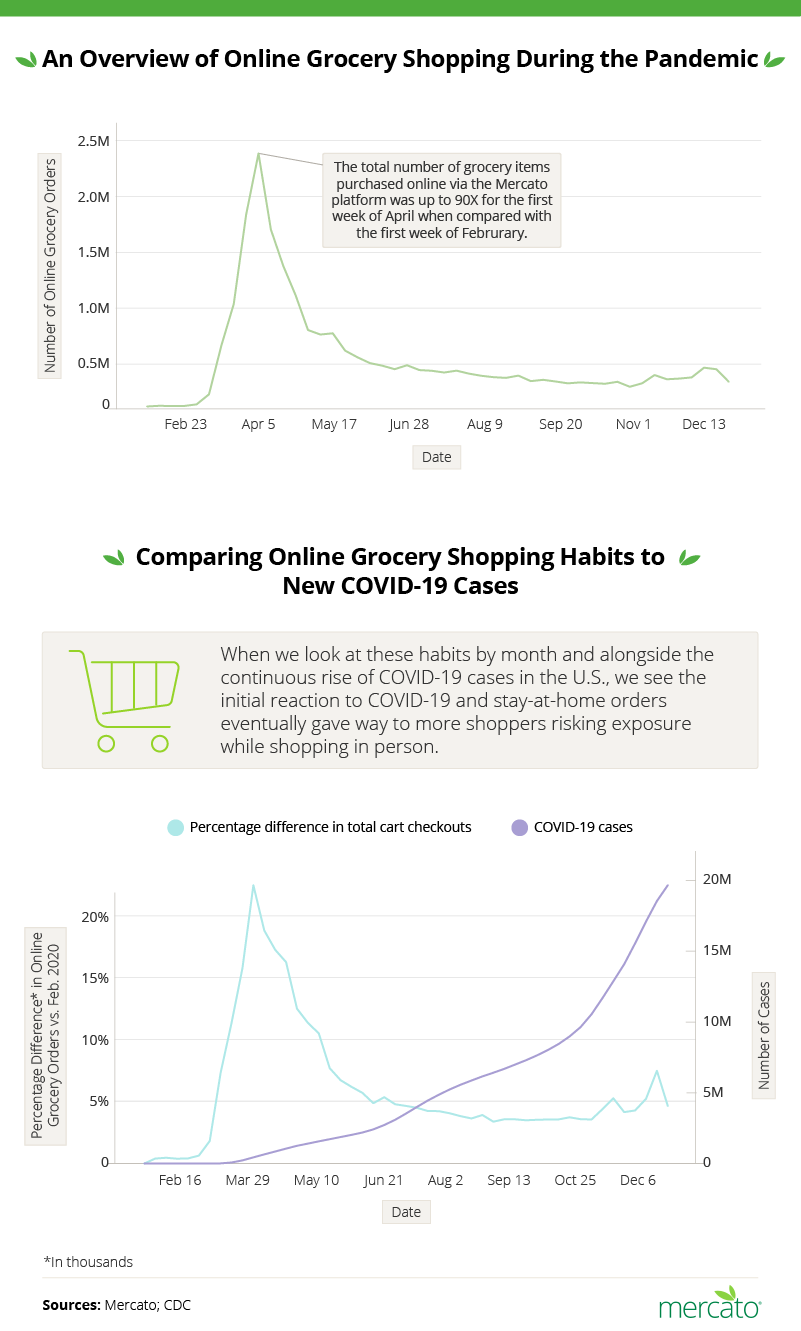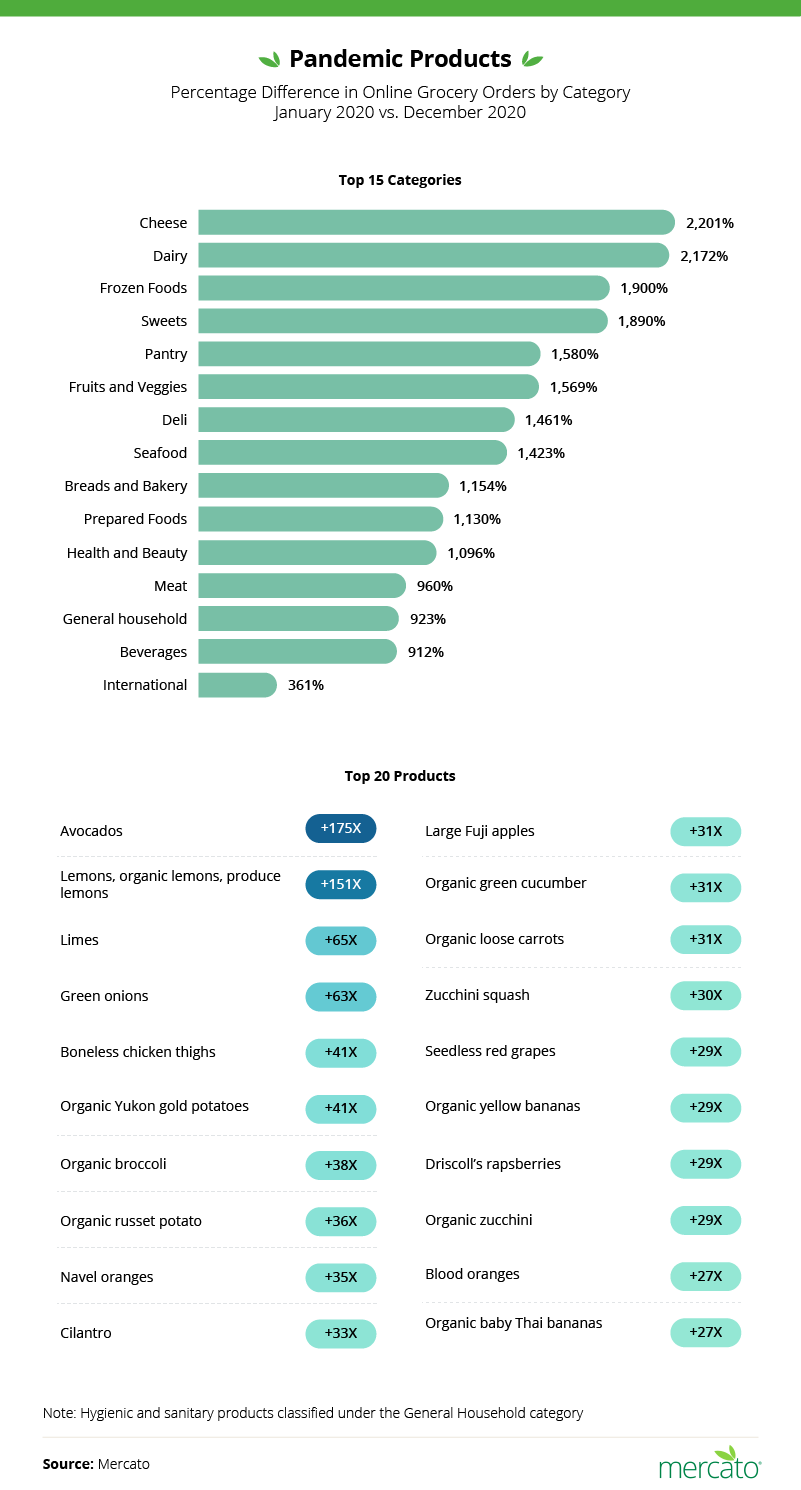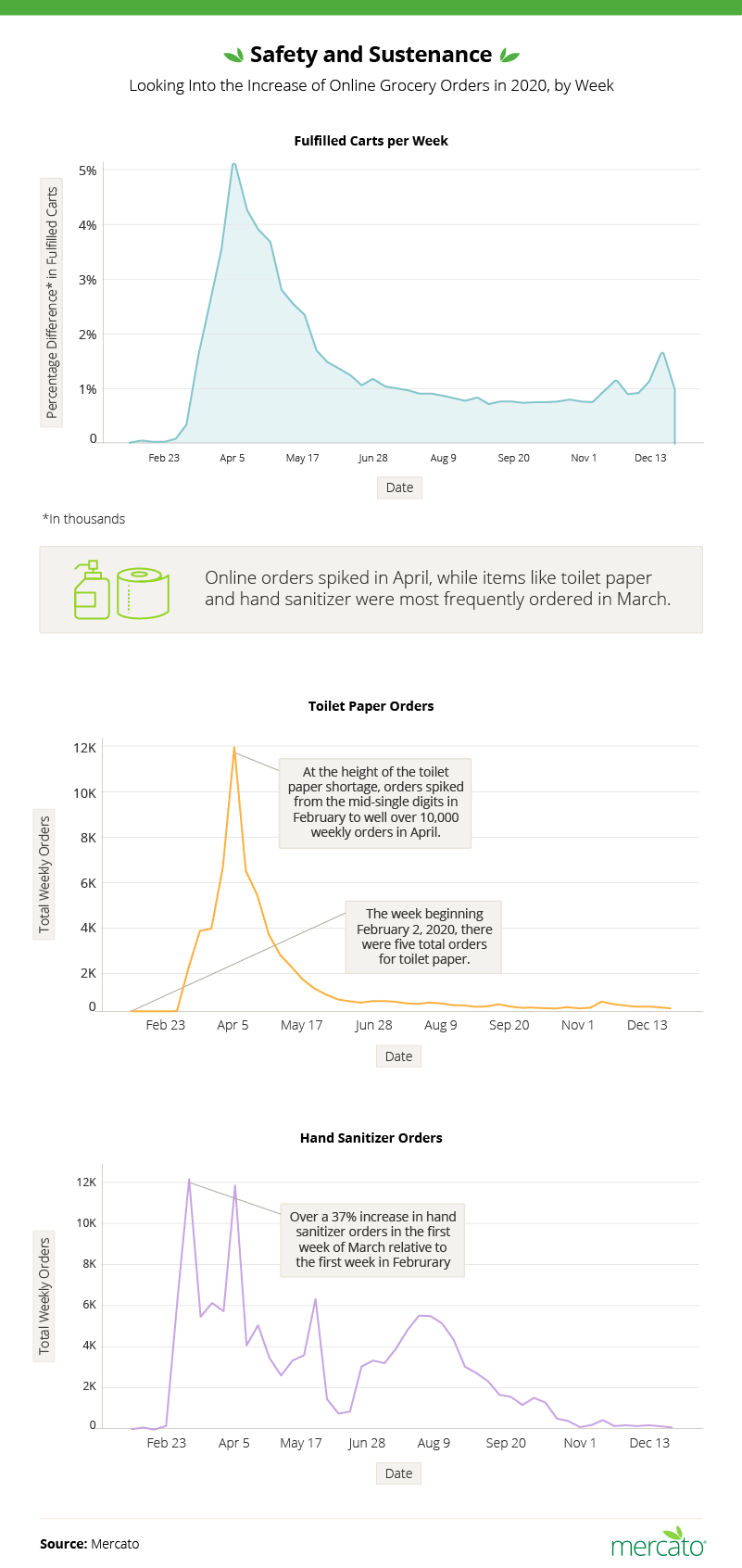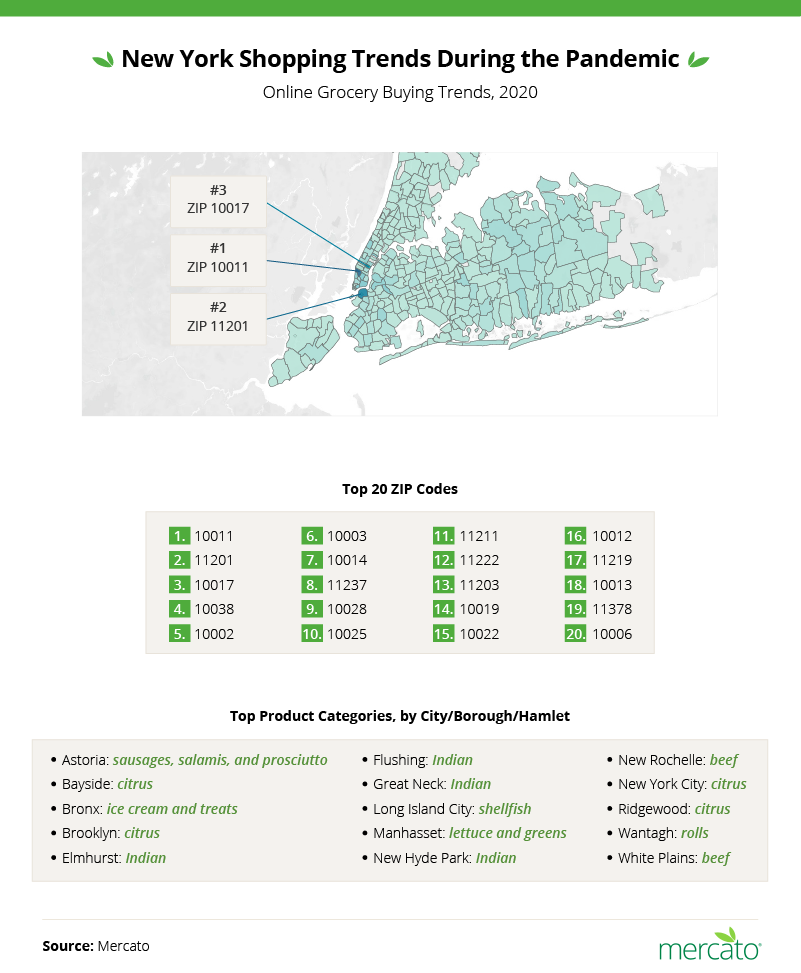Grocery Shopping Trends During Covid-19
How Covid-19 Affected Grocery
Shopping Behavior in the US
Even the strictest social distancers still need to shop for groceries during a pandemic. Amid store closures and supply chain nightmares, this essential errand became one of the trickiest – seemingly overnight.
Toilet paper shortages took over the nation, while grocery stores limited sales in an attempt to stave off hoarding. Shoppers also had to consider the exposure risk they were taking just by physically being in a store.
So what did many people do? They went online.
After collecting sales data from premier online grocer Mercato, we can see exactly what that online grocery shopping looked like. What were people buying online and when?
Did the pandemic leave a lasting mark on online shoppers or have people started buying certain things in person again?
We looked at everything from the top pandemic products during the height of the frenzy to the items that people stopped prioritizing online. We even broke down New York City’s neighborhood sales.
Keep reading for an in-depth analysis of America’s pandemic grocery reaction.
Online Grocery Trends Pre- and Post-Pandemic
The first part of our study used Mercato’s data to show us the percentage change in overall sales each month, starting in January of 2020 and continuing through December of 2020. We also compared the total sales to the total number of coronavirus cases to see how they correlated. Coronavirus data was pulled from the Centers for Disease Control and Prevention.

Online grocery shopping has some obvious perks: It’s convenient, you can access prices from all over the internet, and you don’t have to expose yourself to as many contamination risks.
As is immediately evident from the graph above, people wanted these perks. Even though in-person stores were kept open as essential businesses, online grocery skyrocketed during the height of the pandemic, or in March of 2020.
That said, online sales immediately started tapering off and are heading closer to where they were before March, so it’s still unclear as to whether online grocery shopping will become part of the new normal.
But let’s talk more about this tapering off that occurred almost immediately after the frenzy of March. As you can see in the second graph, the downward trend of online grocery shopping was not matched by an equal decline in COVID-19 cases.
Cases fell somewhat, but not nearly as rapidly as online grocery sales, and even after a spike of cases in June, online grocery sales continued to fall. Why might this be? Perhaps people were ready to take a chance after spending so much time indoors.
Perhaps they felt safer after their local stores rolled out additional hygienic practices, or maybe their local stores had successfully restocked sold-out items by April. Psychologists also explain something called “compassion fatigue” to potentially explain why people take the virus less seriously, even as cases continue to rise. Keep reading for more answers.
Subscription Sales Pre- and Post-Pandemic
The data below takes a quick peek at the percentage difference in subscription sales from Mercato relative to January of 2020. Subscriptions, as opposed to one-off carts, operate slightly differently wherein a person agrees to continue paying the same service fee monthly, typically in exchange for perks.

Even though Forbes insists online grocery sales will continue to rise through 2021, they predict the sales to stem largely from Amazon and Walmart and not in subscription form. As data from Mercato echoes, subscription-based grocery shopping took an even sharper fall post-March than did shopping for individual items.
From January to April, there was over a 14% difference through an increase in subscription sales, but the increase was almost equally matched by a sharp decline immediately after April. Subscription sales are just about back to where they were before the pandemic.
The subscription mentality might be a harder sell than fulfilling a single cart at a time. Especially with the future feeling so uncertain, there’s less of an inclination to agree to something next month. As we’ve seen with this pandemic, things can truly change on a dime.
Top COVID-19 Purchases
As our study turns to look into the specifics, reflect for a moment on your own experiences. What did you start buying online? What couldn’t you find in person? The graph below may provide some reminders.

The “general” category (think hygienic and sanitary products) took off the most. Online sales in this category increased by more than 12,000% from February to March. But toilet paper actually wasn’t the top product sold, as it likely sold out immediately and wasn’t restocked for some time.
Instead, the top product was hand sanitizer, which never experienced similar shortages and continues to remain a household staple. We even saw some of the country’s most popular distilleries switching their business to create hand sanitizer instead of drinkable alcohol. Through these efforts, places like Mercato and other grocers were able to maintain their stock.
Sales of lemons and oranges also experienced some of the top sales increases. Likely due to their high concentrations of vitamin C as well as their relatively long shelf life, these types of purchases make sense during a health crisis. That said, online grocery sales increased across the board, and even some unhealthy purchases, like sausages, saw a 467% increase in sales in March. Bottled water, specifically Poland Springs, sold particularly well that month, with a 4,712% increase in sales.
Toilet Paper and Hand Sanitizer
Toilet paper and hand sanitizer almost became symbols of the pandemic, so we made sure to zoom in on these two crucial supplies. The data revealed some interesting trends in their respective sales, especially in comparison to the pandemic’s overall timeline. The graphs below show toilet paper and hand sanitizer sales by month as well as the overall number of fulfilled carts each week.

The 2020 toilet paper shortage in the U.S. was nothing short of historic. The Atlantic called it “The Great Toilet Paper Panic,” naming it after the same phenomenon occurring in 1973. They explained that both shortages were actually due to misinformation:
After one news outlet announced that there was a shortage (even though there wasn’t), everyone believed it and stocked up as much as possible, creating the shortage they were so afraid of. This is also reflected in the toilet paper sales graph:
We see an initial spike of sales in March followed by a drastic decline (likely after selling out) followed by a repeated spike (perhaps once it had been restocked). Things finally began to ebb and normalize as the world returned to their normal toilet paper purchasing habits.
Hand sanitizer also saw a drastic rise in March followed by a plummet in April and another spike that same month. Unlike toilet paper, however, hand sanitizer continues to be an abnormally popular online purchase.
While toilet paper is used at a rate consistent with pre-pandemic levels, hand sanitizer is not. Instead, hand sanitizer is much more popular today than it was before March. Economy-sized bottles have become the norm, as we simply use more of it.
This is why the hand sanitizer sales graph continues to bounce around and has yet to stabilize. In comparison, general cart fulfillment has steadily normalized since its initial spike in March.
NYC Online Shopping Trends
Lastly, our study honed in on the city hit hardest by the pandemic: New York City. How did a city undergoing such emotional and physical turmoil make sure they had something to eat? The graph below gives some answers.

ZIP code 10011 in the Chelsea neighborhood of NYC started online shopping the most, or at least increased their online sales the most, during the height of the pandemic.
Chelsea is known to be a particular haven for artists. The older buildings’ high ceilings and freight elevators enabled larger works of art to be completed and transported more easily. There are currently more than 300 art galleries in this neighborhood alone, and, apparently, many grocery deliveries are being made there as well.
Chelsea residents’ orders increased by more than 22,000% in March. Brooklyn, also an artist haven, wasn’t far behind and saw a similarly large spike in grocery orders at the time. Brooklyn, however, was particularly interested in ordering oranges. Perhaps to eat, perhaps for some still-lifes.
In reality, it is unclear as to why these particular neighborhoods shopped online the most despite their cultural similarities.
New York City’s top product category was canned goods. This suggests two things: First, that there was a long-term mindset in place with regards to preparedness; and second, that the attempts to go outside were more limited and therefore required foods with a longer shelf life.
In other words, New Yorkers who really didn’t want to go outside would have been more likely to stock up in single trips on foods that would last instead of making repeated trips for foods that might expire quickly.
Online vs. In-Person Groceries
Even though the perks of online grocery shopping haven’t gone anywhere, the vehemence for them has. Shoppers appear to be returning to their normal habits, even in areas where the coronavirus is still heavily present. It appears that it’s really just hand sanitizer sales that won’t return to where they were pre-pandemic any time soon.
Online grocery shopping, however, is still a way to limit your exposure risk. It’s also a way to more easily compare products that fit your personal preference, as well as save time and gas money. If this is something that still appeals to you, Mercato is ready to help.
They’re the experts in online grocery shopping and can offer you a variety of products at reasonable prices or even a handy subscription service. Head to Mercato today to weigh your options.
Methodology and Limitations
Using Mercato order data from March 22, 2020, to July 31, 2020, we analyzed trends in online grocery sales volume and the popularity of different product categories overall and based in New York.
While Mercato has locations across the country, these data cannot be considered a representative national sample. The data presented here are based solely on the trends of Mercato customers. Data were not normalized to reflect variance in participating merchants by area. Therefore, some of these measures would have been influenced by the number of merchants in a given area available on the Mercato platform.
Fair Use Statement
The world and its grocery habits were certainly rattled by the pandemic. If you know someone who could benefit from data that helps explain it, you are welcome to share this article with them. Just be sure to link back to this page and that your purposes are noncommercial in nature.
